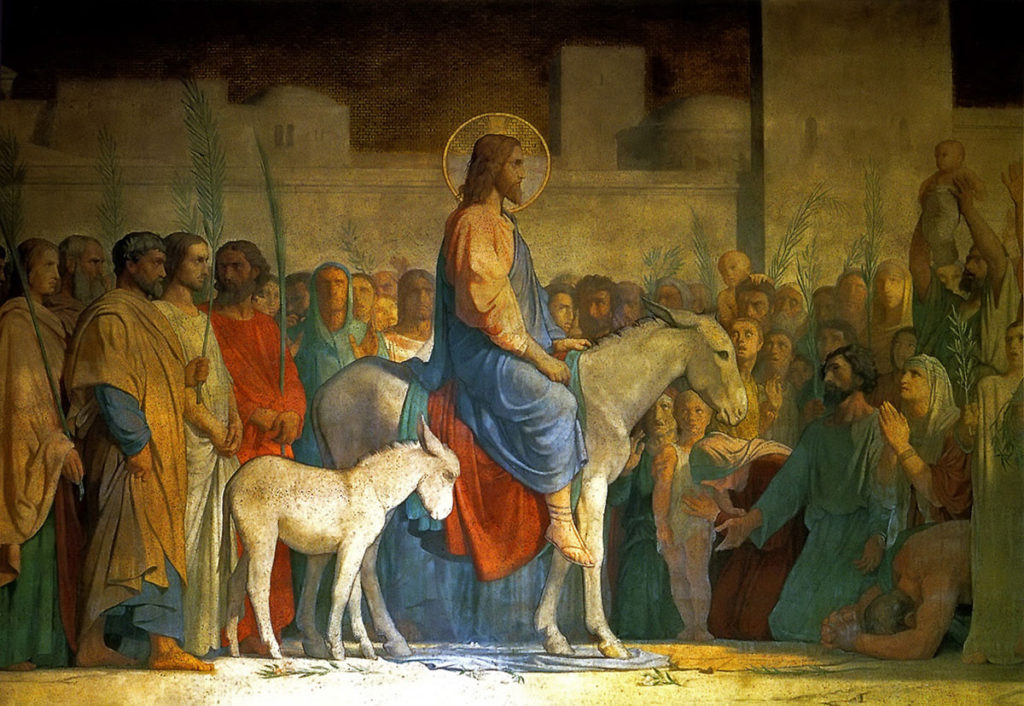All about Holy Week
 Holy Week
Holy Week
The most solemn week of the Christian year, Holy Week is the week leading up to Easter, and is the week during which Christians particularly remember the last week of Jesus’ life. Holy Week begins on Palm Sunday — 9 April.
Palm Sunday
Palm Sunday commemorates Christ’s triumphant arrival in Jerusalem to the cheers of the crowd.
The next day the great crowd that had come for the Feast heard that Jesus was on his way to Jerusalem. They took palm branches and went out to meet him, shouting, “Hosanna!” “Blessed is he who comes in the name of the Lord!” “Blessed is the King of Israel!” John 12:12-13
Later in that week many of the people in that cheering crowd would be among those shouting that Jesus should be executed.
In many churches, during Palm Sunday services, large palm branches are carried in processions. In Anglican and Roman Catholic churches, members of the congregation hold small crosses made of palm leaf, both to remember the palm leaves which the people of Jerusalem waved when Jesus arrived, and to remember the cross on which he died.
Some Christians display the crosses from that service in their homes during the year as a symbol of their faith. The crosses are burned at the start of Lent the next year to provide the ash for Ash Wednesday.
Maundy Thursday (liturgical colour – white)
Jesus washed the feet of his disciples. Maundy Thursday is the Thursday before Easter. Christians remember it as the day of the Last Supper, when Jesus washed the feet of his disciples and established the ceremony known as the Eucharist.
The night of Maundy Thursday is the night on which Jesus was betrayed by Judas in the Garden of Gethsemane. In many other countries this day is known as Holy Thursday.
The word maundy comes from the command (mandate) given by Christ at the Last Supper — that we should love one another.
It was common in monasteries throughout history for the Abbot to wash the feet of the monks in a similar gesture. Some other churches nowadays also have foot-washing ceremonies as part of their Maundy Thursday services.
Good Friday
Good Friday commemorates Jesus’ crucifixion. It is the most solemn day of the Christian Year.
The most important events in Christianity are the death and later resurrection of Jesus Christ, who Christians believe is the Son of God, and whose life and teachings are the foundation of Christianity. Good Friday is the Friday before Easter. It commemorates the Passion: the execution of Jesus by crucifixion.
Good Friday is a day of mourning in church. During special Good Friday services Christians meditate on Jesus’ suffering and death on the cross, and what this means for their faith. In some countries, there are special Good Friday processions, or re-enactments of the Crucifixion.
The main service on Good Friday takes place between midday and 3pm. In many churches it takes the form of a meditation based on the seven last words of Jesus on the cross, with hymns, prayers, and short sermons.
The Bible quotes seven last sentences that Jesus spoke from the Cross.
- Father, forgive them; for they do not know what they are doing. Luke 23:34
- Truly I tell you, today you will be with me in paradise. Luke 23:43
- Woman, here is your son… Here is your mother John 19:26
- Eloi, Eloi, lema sabachthani? (My God, My God, why have you forsaken me?) Mark 15:34
- I am thirsty. John 19:28
- It is finished. John 19:30
- Father, into your hands I commend my spirit. Luke 23:46
Holy Saturday
Holy Saturday is the Saturday after Good Friday which is often, but wrongly, called Easter Saturday.
Easter Vigil (liturgical colour – white)
The Easter vigil service is the first Easter service, and takes place on the night of Holy Saturday.The idea behind the service is for faithful Christians to wait and watch, hopeful and confident that Christ will return at midnight. The Easter, or Paschal, candle is lit during this service. The service traditionally begins outside the church, where minister and some worshippers gather around a fire – a charcoal brazier is common.The service begins with words such as these:
Brothers and sisters in Christ, on this most holy night, in which our Lord Jesus Christ passed over from death to life, the Church invites her members, dispersed throughout the world, to gather in vigil and prayer. For this is the Passover of the Lord, in which through word and sacrament we share in his victory over death.
After readings and prayers, the Paschal candle is lit from the fire using a taper, while a prayer like the one below is said:
May the light of Christ, rising in glory, banish all darkness from our hearts and minds
The lit candle is now a symbol of Christ, risen as the light of the world, and come into the midst of the people.
After being lit outside, the candle is carried into the church, where most of the worshippers are waiting in darkness, which symbolises the darkness of Christ’s tomb. After more prayers and readings, the candles held by the congregation are lit from the Paschal candle.The symbolism of the candle is made very clear by words such as…
Grant that this Easter candle make our darkness light; for Christ the morning star has risen, never again to set, and is alive and reigns for ever and ever. Traditional Easter vigil service
The readings at the service tell of the creation of humanity, how humanity fell from grace, and was repeatedly rescued by God. The readings remind people of God’s promise to be with them always.
Easter Sunday (liturgical colour – white)
Easter is the Sunday of the Resurrection and the Principal Feast of the Christian Church.
Source: BBC — archives
***